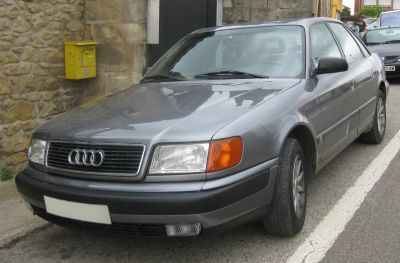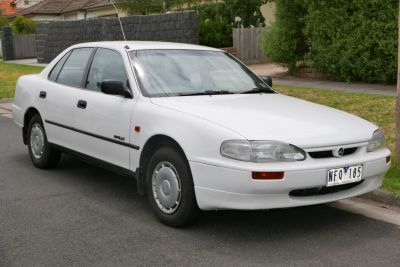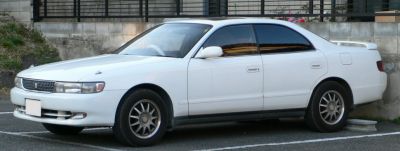 1996 Toyota Cresta (GX100) Dimensions, Size & Specs
1996 Toyota Cresta (GX100) Dimensions, Size & SpecsMeasurements of the 1996 Toyota Cresta, engineered for optimal performance and comfort
| Dimensions | |
|---|---|
| Length: | 4750 mm187.0 in15.6 ft |
| Width: | 1755 mm69.1 in5.8 ft |
| Height: | 1420 mm55.9 in4.7 ft |
| Weight Specifications | |
| Maximal permitted Weight: | 1330 kg2932 lbs |
| Tire Specifications | |
| Rims Size: | 15-inch rims:
|
| Tire Size: |
|
The Toyota Cresta GX100, produced between 1996 and 2001, is a well-regarded mid-size sedan known for its balanced dimensions and solid construction. Measuring 4750 mm (186.6 inches) in length, 1755 mm (69.1 inches) in width, and 1420 mm (55.9 inches) in height, the GX100 Cresta offers a roomy yet manageable footprint that fits well within the mid-size sedan category. With a maximum curb weight of 1330 kg (2932 lbs), it provides a stable and comfortable ride, emphasizing efficiency and driving stability. The sedan rides on 15-inch rims (6JJ x 15) equipped with tires sized 195/65 R15, which contribute to a smooth driving experience that balances comfort and control. These tire dimensions are common in this vehicle class, affording adequate grip and handling performance for everyday driving. The GX100 generation of the Toyota Cresta carries the legacy of a practical, stylish sedan designed for individuals seeking a dependable vehicle with moderate size and weight. Thanks to its carefully considered dimensions, the car offers comfortable interior space without compromising maneuverability in urban and highway environments. The vehicle's relatively low height of 1420 mm ensures improved aerodynamics and a lower center of gravity, enhancing driving stability. Its width places it comfortably in the compact boundaries while still offering generous interior room for passengers. Overall, the Toyota Cresta GX100 remains a practical option in the used sedan market, combining classic design with specifications that emphasize balance, comfort, and utility.
Discover the standout features that make the 1996 Toyota Cresta a leader in its class
Have a question? Please check our knowledgebase first.
The Toyota Cresta (GX100), produced from 1996 to 2001, features a length of 4750 mm (187 inches), a width of 1755 mm (69.1 inches), and a height of 1420 mm (55.9 inches). These dimensions give it a balanced profile typical of mid-size sedans of its era, providing a spacious interior for passengers and cargo while maintaining manageable exterior size for urban and suburban driving.
The Toyota Cresta (GX100) has a maximum weight (curb weight plus payload) of 1330 kg (approximately 2932 lbs). This relatively moderate weight allows for a good balance between fuel efficiency, handling, and ride comfort. The vehicle's engineering aims to optimize performance by keeping the weight in check, which aids in delivering a smooth driving experience while maintaining reasonable fuel consumption within the mid-size sedan class.
For the Toyota Cresta (GX100), the standard rims measure 6JJ x 15 inches, paired with tire sizes of 195/65 R15. This setup offers a good combination of comfort and handling appropriate for a sedan. While it's possible to upgrade to larger rim and tire sizes for aesthetic or performance reasons, such changes may affect ride quality, speedometer accuracy, and suspension components. It is advisable to consult with a tire specialist and consider potential modifications for compatibility.
With a length of 4750 mm (187 inches), a width of 1755 mm (69.1 inches), and height of 1420 mm (55.9 inches), the Toyota Cresta (GX100) generally fits comfortably into a standard single-car garage. Most standard garages have widths around 2.4 to 2.7 meters (8 to 9 feet) and lengths of approximately 5.5 to 6 meters (18 to 20 feet), providing enough clearance for the vehicle's dimensions, along with room to move around safely for entry and exit.
Compared to the previous generation Toyota Cresta (often the GX90 series), the GX100 maintained a similar mid-size sedan profile but with subtle increases in length and refinement. The GX100 at 4750 mm in length was slightly longer than the predecessor, which contributed to improved cabin space and ride comfort. Width and height changes were minimal but aimed at modernizing the car's stance and aerodynamics. Overall, the GX100 is a modest size evolution focusing on enhancing passenger space and-road presence.
When compared to other mid-size sedans of the late 1990s and early 2000s, such as the Nissan Cefiro or Honda Accord, the Toyota Cresta (GX100) holds up competitively. Its length of 4750 mm (187 inches) and width of 1755 mm (69.1 inches) place it squarely in the mid-size category, offering ample interior room without crossing into full-size territory. Its proportions are well suited for comfort while still manageable in urban environments, making it comparable in footprint and practicality to its contemporaries.
The exterior dimensions of the Toyota Cresta (GX100) translate into a spacious interior cabin typical for a sedan in its class. The generous length of 4750 mm (187 inches) and width of 1755 mm (69.1 inches) allows for comfortable seating of up to five passengers. Headroom and legroom benefit from the 1420 mm (55.9 inches) height, creating a balanced environment between sporty styling and passenger comfort. The interior layout is designed to maximize usable space, focusing on ergonomic seating and cabin accessibility.
The height of 1420 mm (55.9 inches) on the Toyota Cresta (GX100) contributes significantly to its aerodynamic profile. A moderately low height helps reduce air resistance, improving fuel efficiency and high-speed stability. Simultaneously, this height keeps the center of gravity relatively low, which positively influences handling and cornering performance. The balance between height and width also supports overall stability and driving confidence, making the sedan capable in both city and highway conditions.
While the exact ground clearance for the Toyota Cresta (GX100) is typically around 140-150 mm (5.5-6.0 inches) depending on suspension setup and tire options, this clearance is typical of mid-size sedans. It allows the Cresta to handle regular paved roads and mild uneven terrain with ease. However, it is not designed for rough off-road conditions due to its relatively low clearance. The suspension is tuned more for comfort and stability on urban and suburban roads.
The Toyota Cresta (GX100) brought a more refined and modernized exterior styling compared to earlier models, featuring smoother lines and a more aerodynamic silhouette. The front end design adopted sleeker headlights and grille details, aligning with the design trends of the late 1990s. Its dimensions allowed for a balanced stance that was less boxy than predecessors, giving the car a contemporary look emphasizing elegance and subtle sportiness. These updates enhanced both visual appeal and aerodynamic efficiency.
Discover similar sized cars.

| Production: | 1955-1962 |
|---|---|
| Model Year: | 1955 |
| Length: | 4800 mm189.0 in |
| Width: | 1790 mm70.5 in |
| Height: | 1470 mm57.9 in |

| Production: | 1957-1962 |
|---|---|
| Model Year: | 1957 |
| Length: | 4800 mm189.0 in |
| Width: | 1790 mm70.5 in |
| Height: | 1470 mm57.9 in |

| Production: | 1989-1991 |
|---|---|
| Model Year: | 1989 |
| Length: | 4690 mm184.6 in |
| Width: | 1695 mm66.7 in |
| Height: | 1355 mm53.3 in |

| Production: | 1990-1994 |
|---|---|
| Model Year: | 1990 |
| Length: | 4790 mm188.6 in |
| Width: | 1777 mm70.0 in |
| Height: | 1431-1437 mm56.3-56.6 in |

| Production: | 1991-1996 |
|---|---|
| Model Year: | 1991 |
| Length: | 4725 mm186.0 in |
| Width: | 1770 mm69.7 in |
| Height: | 1420 mm55.9 in |

| Production: | 1991-1996 |
|---|---|
| Model Year: | 1991 |
| Length: | 4725 mm186.0 in |
| Width: | 1770 mm69.7 in |
| Height: | 1400 mm55.1 in |

| Production: | 1992-1996 |
|---|---|
| Model Year: | 1992 |
| Length: | 4750 mm187.0 in |
| Width: | 1750 mm68.9 in |
| Height: | 1390 mm54.7 in |

| Production: | 1992-1996 |
|---|---|
| Model Year: | 1992 |
| Length: | 4750 mm187.0 in |
| Width: | 1750 mm68.9 in |
| Height: | 1390 mm54.7 in |
